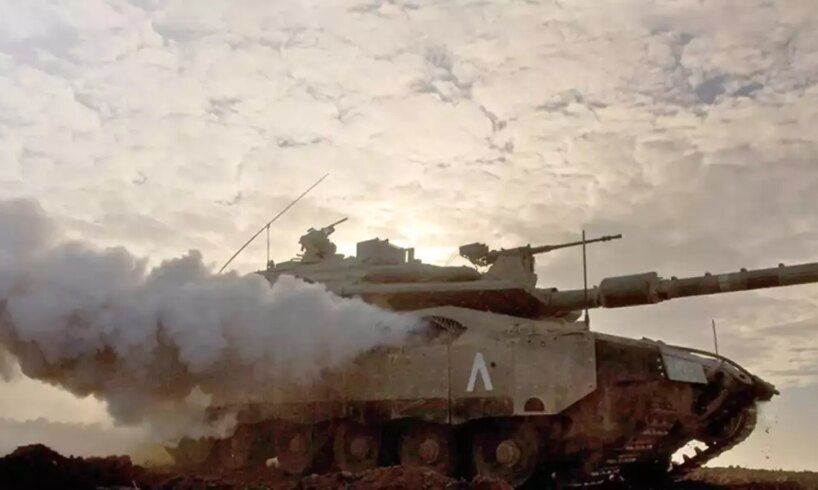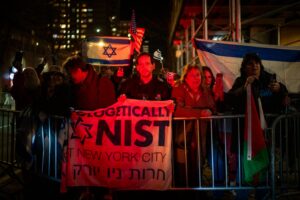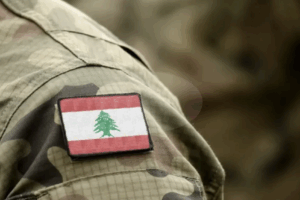
The last recording of Omer Neutra is still chilling two years on, as if the black Shabbat were only yesterday. Omer calls for help and the war room replies with a spine-tingling answer that recalls the Yom Kippur War: “Forces are on their way to you.” But there are no forces and the tank is surrounded by heavily armed terrorists. Crew 3 of the storied 77th Battalion keeps fighting. With almost no ammunition, facing hundreds of terrorists, they display supreme courage to save civilians until the final moment.
Fragments of the unbelievable story of the 7th Armored Brigade’s combat soldiers have been published over the past two years. We heard about Ido Somekh, who kept fighting after his entire crew was killed. We met Bar Zonshein, who had to make a terrible decision and fire at a pickup truck full of terrorists even as he understood there might be hostages inside. But you have never heard them like this.
“On October 7 at 10 in the morning I grabbed one of the brigade’s commanders in the middle of the chaos and asked what my job was. He said, ‘Leave me, we’re in a war, like Yom Kippur.’ That is when I understood my role. This is what has to be done. Now we are writing the brigade’s legacy,” says Master Sgt. (res.) Avichai Berg, the 7th Brigade’s heritage officer.
Berg is a tour guide at the Shaar Hagai Field School and an expert on the battle of Latrun in the 1948 War of Independence, where the brigade was born. This time he understood the mission was his. He would have to tell the story. “I asked on Facebook who could get me recording devices and within 24 hours a car showed up with five recorders and three cameras. I headed south and started running after the commanders. I interviewed them under fire. In israel, we always remember to interview combat soldiers properly only 30 years after a war, which has very little historical value. This time we did it in real time. We documented history as it unfolded.”
Tanks on the Gaza border. Photo: IDF Spokesperson’s Unit IDF Spokesperson’s Unit
The result, published here for the first time and shown in a film produced by the 7th Brigade (creator: Shai Noylander; cinematography: Master Sgt. Ariel Zandberg; interview editing: Karo Tzur) that will be released soon, defies belief. Twelve tanks against thousands of terrorists. The few against many. Fighting until the last round and then using the tracks to run over the murderers. Serving as a human shield, fully aware they would likely not make it out alive, to protect civilians. Charging like in a movie into the flames, moments before Hamas’ Nukhba terrorist force could win the day and change the course of the war.
Crews from two tanks were abducted into Gaza that awful day, with one survivor in each tank: the tank commanded by Omer Neutra, which fought in the southern envelope, and the tank of Daniel Peretz, which fought and came under attack near Kibbutz Kfar Aza.
“It actually started a bit before Shabbat morning,” says B., who in October was a platoon commander in the Hermon Royalty Company. “On Monday my whole platoon rotated out. I got entirely new crews. On Thursday night we had a platoon ‘poike’ night, our first bonding evening with music and a guitar, and we ate the stew that Ido Somekh cooked. The next day we had a magical Shabbat dinner on base. Kiddush, blessings, sitting together. We had a talk and went to sleep.”
“In the two weeks before October 7 there were daily riots along the border fence. We were in that tense situation for two weeks,” says Bar Zonshein, commander of the Vulcan Company. A few days before that week the marches stopped and the combat soldiers and commanders enjoyed what turned out, in hindsight, to be deceptive quiet. Because of the holidays, the area around Nir Oz was reinforced with an extra tank. “Neutra’s crew was not supposed to be on weekend duty.”
Only 12 tanks were positioned in the sector of Battalion 77 on the night of October 6–7. Company H, Hermon Royalty, held the northern brigade sector, up to around Reim Junction. Company V, Vulcan, held the area from Reim Junction down to the Egyptian border, under the southern brigade. The map was terrifying. Facing the entire Gaza Strip, with its dense neighborhoods teeming with terrorists, stood a handful of tanks.
05:30
Dawn alert
In the early morning hours the tankers woke up and moved to positions as part of the regular dawn alert. “I didn’t feel anything was off,” recalls Eliad Yaakov, a platoon commander in Company H, during a tour of the peaceful sites that became a battlefield. “There was nothing suspicious or special. A routine morning on the line. In my crew everyone is already inside the tank at our positions, with combat gear, the situation assessment ends and I’m watching a show on my phone.”
“We went on dawn alert, basically climbed into the tank and went back to sleep. My commander was listening in,” recalls Yehonatan Pinto from Company V, in a tank parked near Kibbutz Kerem Shalom. “Right before 6:30 I wake up and look at my commander. I want to offer to relieve him, something like that. He just looks at me for a minute and then suddenly we hear a boom.”
The Gaza border fence is breached by Hamas bulldozers on October 7 Arab Networks
Zonshein, the Vulcan Company commander, realizes something dramatic is happening. “I just walk out of the war room and jump into a tank toward Hill 147, the nearest hill,” he says in the film. “On the way the brigade commander, Asaf Hamami, comes up on the net and tells me: ‘Reporting line 163, complex incident in Nirim. We are at war, do everything to get there.’ That was the last time I spoke with Hamami.”
“All the systems are already loaded. We have a shell in the barrel, machine guns ready,” says Eliad. In footage from October 7, his tank is seen moments before climbing into a firing position for the first engagement with terrorists. The tank pulls up and then Eliad and his crew grasp for the first time what they are facing. It is not just “purple rain,” the army’s code for incoming mortars and rockets. It is something else entirely. “We are identifying many terrorists already starting to cross the fence.”
06:29
Ido’s crew near Kibbutz Sufa
Eliad’s crew near Kfar Aza
B.’s crew near Kibbutz Beeri
On October 22, 2023, I spoke for the first time with 2nd Lt. Ido Biton. In the pre-interview briefing I was told his crew killed 120 terrorists that cursed morning, but he and his crew asked me to write that they killed “only” 80 terrorists “so people won’t think we exaggerated.” Later residents of Kibbutz Nir Yitzhak would write to me that the tank crew saved their lives and prevented a massive incursion into their community. The officer, the youngest in the company at the time, has since finished the company commanders’ course.
“We let a shell go, blew the pickup into the air, and then you see another column of 70 or 80 terrorists just running with their rifles held high. We fire, fire, fire until the whole column starts to run back into the Strip,” Biton says in the film, pointing toward Khan Younis. With the flower fields of Nir Yitzhak behind them and dozens of terrorists in front, they understood this was a fight for their lives. “The second we fire a shell, we get hit by an anti-tank round and a drone drops a grenade over my head. Because the hatch was shut I’m not dead.”
At the same time, on the other side of the northern sector, Eliad’s crew, not far from Kfar Aza, also enters the fight. On the radio he hears the sector commander, Maj. Shila Har-Even, later killed in action, instructing forces to defend Kfar Aza. On the way they encounter terrorists directly in front of them. Yahav, the driver, runs one over. The rest are cut down by the tank’s machine guns.
When they reach the kibbutz, the crew tries to understand what is happening. “He scans and we don’t identify much, not even smoke.” Bar asks, “Are you sure there is anything here?” and Eliad answers, “That’s what I understand from the radio.” The force does not realize the terrorists are already inside and are carrying out a massacre. They begin a blocking battle. They kill dozens on the fence but do not understand that terrorists inside the kibbutz are committing atrocities.
Not far away, another platoon commander, Yotam B., leads a platoon battle group. “Change here Two, beginning movement to our missions,” he orders. “My platoon sergeant, Shai Levinson [name and rank], salutes that he received the order and starts moving. I remember shouting over the external intercom, ‘Levinson, activate Trophy.’ He just signals with a salute that he got me. Leaving the outpost he overtakes me, cuts across the farmers’ fields and I see the tank disappear into the grove. That was the last time I saw Crew 2-B.”
B. enters the woods and pulls into position. “I traverse to the right and the next thing is I hear a crazy explosion and feel the tank shaking.” Later he learned from a Hamas video that a drone dropped an anti-tank missile on the turret. “I see a massive fireball. The tank starts to burn. On the net you hear the observation soldiers screaming, commanders screaming, gunfire, people burning alive. All the observation soldiers are crying on the net with our sector’s code words. ‘Hurricane, hurricane, hurricane.’ And I think I’m in a film. I think I’m still asleep and this is a nightmare I’ll wake up from in a few minutes in a panic. I pinch my arm.”
B.’s crew starts firing shells while the driver manages to get the tank moving. “I am amped up and the radio goes silent because most are already dead, it turns out, and there is nobody to command the forces. Then my sergeant’s driver comes up on the external with screams: ‘Two, this is Agalon 2-B, my entire crew is hit. I’m the only one left. There’s fire in the turret.'”
Levinson’s crew | near Kibbutz Reim
Ido Somekh, the driver of Tank 2-B, is the sole survivor from the tank and has one of the day’s boldest heroism stories. The crew had never been in a tank together before, but the commander did not let that stop them. “Fire, fire, fire, fire,” Levinson is heard shouting on the net. “Run them over. Gunner, engage. Move.”
For 20 minutes the tank fights dozens of heavily armed terrorists, then the tank is hit. The radio audio in the film is bone-chilling. “Somebody’s firing at us. RPG. Son of a… left, hard,” Levinson yells amid the attack. “Grenade to the right. Driver stop. Everyone okay? Ahhh.” An anti-tank missile struck the rear of the tank. Levinson was killed in the hit, dragged into Gaza and recovered in a special operation this past June.
“I don’t remember the explosion. I remember choking on smoke after,” says Somekh. The gunner, Ariel Eliyahu, was killed in the hit. The loader, Ofir Testa, was nowhere to be seen. “I see fire in the turret and everything is smoke. As far as I am concerned I am alone in the tank at that moment and I know I have to get out.” Coughing and barely breathing, he reports to his commander B. that he is the only one left. The commander tries to calm him. “Take a deep breath, relax, open Google on your phone. Get as far from the fence as you can.”
Somekh barrels toward the Gaza envelope and after he realizes he has shaken the terrorists he stops. Then he hears Testa for the first time. Testa has managed to cling to the outside of the tank and calls to him. “He was burned but functioning,” Somekh recalls.
Testa climbs into the tank and comes on the net, his voice clearly wounded. “This is 2-B. The commander is not in the tank. Our gunner is dead. Loader wounded. We don’t know our location.” The two struggle to figure out where they are and decide to drive east toward the sun. Eventually they reach the site where a party had been going on moments earlier. The Nova site.
“We did not know there had been a party here,” Somekh says. “We decide to block them with the tank, to stand between both sides.” One of the security guards asks Testa to hand him a weapon, but when Testa steps out he takes a bullet and is killed on the spot.
Armored tank in Gaza. Photo: Hanan Greenwood Hanan Greenwood
From the whole crew only Somekh remains. “I am alone in the tank and I realize I am going to die too. There is no way to survive this. I decide I am not going to be abducted. I chamber a round, move to the loader’s area, aim at the cupola and wait. A terrorist arrives. He sees me and panics and in his panic drops his weapon. I shoot him. The rest of the terrorists start throwing grenades into the tank and I start jerking the tank around until it finally stalls.”
In extraordinary footage published about a year ago, the tank is seen running over cars on Route 232 in an effort to push the terrorists back. “I had to run some of them over to get forward,” Somekh explains. Eventually the tank grinds to a halt.
Near the tank Ido encounters two men trying to escape with the armored vehicle and after he explains it is disabled they head to their car, move the dead driver and try to get through on the road. They hide in the fields and feign death but two terrorists with knives approach and Somekh shoots one. The terrorists attack him with knives and stones but his helmet saves him. The two Israelis with him are murdered there. He hides in another bush with two festival-goers, unconscious most of the time from his wounds. At 5 p.m. he is evacuated to Soroka Medical Center.
Chayon’s crew | near Kibbutz Erez
Platoon commander Guy Chayon’s crew was entirely new on the morning of October 7, only a few days into the job. None of that mattered to the terrorists, who launched their assault in the northern Gaza envelope. He hears the explosions in the distance, but once he dons the Gentex tanker helmet he understands something terrible is underway. “I cannot stop hearing the observation soldiers reporting their identifications. Tons of reports. At some point I hear one of them say there are terrorists in the position and I decide to drive with the crew.”
At a certain point during the fighting, an RPG penetrates and hits the ammunition feed. Terrorists try to attach an explosive to the rear door of the tank but the driver manages to extract. The crew tries to hit the attackers but struggles to identify them because of the state of the vehicle. “I understand I am alone alone. I don’t know how many terrorists are around me and if this tank stalls I will not make it.”
The October 7 attack. Photo: AFP AFP
The tank backs out and the crew tries to fix its weapons systems. A Golani Brigade platoon commander gets in touch and asks for covering fire in a battle at the Nir Am Water Museum. In hindsight it turns out to be one of the day’s most consequential battles. “I pop my head out and see dozens of terrorists who arrived in minivans. I reverse quickly. I don’t know how many we ran over. I try to understand what is going on and then boom. I get hit by two or three anti-tank rounds at once. Everything collapses. All the systems go down. I was sure that is it, they are about to pull me out. I didn’t feel it at the time, but I suffered burns to my face and hands.”
Chayon understands he is ineffective and decides to navigate by Google to Route 232. At the Shaar Hanegev junction he sees horror. “A family was murdered and everything is fresh.” The crew is dismounted and the loader is evacuated by rescue services after a severe combat stress reaction. Around 11 a.m. a discharged soldier contacts him and picks up the crew without the tank in a tiny Suzuki Swift and takes them to Camp Yiftach. “We saw so many bodies along the way, ours and theirs. It was surreal.” Later in the day he returns to a tank under the company commander and takes part in retaking the Erez Crossing.
06:29
Zonshein’s crew near Kibbutz Kissufim
Neutra’s crew and Zapolsky’s crew near Kibbutz Nirim
Bar Zonshein, commander of Company V, had no idea what drama was unfolding in the northern brigade. At 6:29 he was at the Mars outpost between Kibbutz Kissufim and Kibbutz Ein Hashlosha. As ordered by the southern brigade commander, Col. Asaf Hamami, moments before he fell in battle, he races toward Nirim and engages dozens of terrorists.
The southern brigade’s biggest problem was the collapse of command and control because most of the senior commanders in the field were killed or wounded. A few company and platoon commanders ran the battle. Zonshein called the brigade war room and asked, “Just tell me where there is an infiltration,” but the list begins to count 22 breach points.
Zonshein faces an enormous dilemma about where to go, decides to leave the Nirim area and head to the space between Kibbutz Kissufim and Nir Oz. On the way he eliminates quite a few terrorists. Near Ein Hashlosha he is able to raise one of his crews on the net for the first time. It is Eyal Zapolsky, commander of Tank 3-B. “He had been Omer Neutra’s tank commander.”
A few hours earlier Zapolsky had left the “White House” outpost not far from Nirim together with the platoon commander, Omer Neutra. When the two tanks reach the Burma axis, the service road along the fence, Neutra tells Zapolsky to turn north and he heads south.
Seconds after Zapolsky’s tank reaches the fence they see two terrorists working on it and open fire. “Then about a minute later we hear a huge boom inside the tank.” Zapolsky is thrown around and understands they have been hit by an anti-tank missile. He evacuates his loader but refuses to be evacuated himself despite a neck wound. “I signaled to the medic ‘no’ with my head and shut the hatch behind me. We climbed up and took down the two terrorists who were on the fence.”
At this point Berg interrupts him and asks why he did not evacuate. “The truth is I thought the incident would end in a second and a half, that it was an hour-long event and that I could hold for that hour. I have my crew and I cannot just abandon them in the middle of a battle space. I have two hands, two legs, ten fingers, everything in place. I feel I can keep going.”
In an extraordinary step, Zapolsky commanded a tank without a loader. “I was hopping between stations. I would identify targets from the commander’s position, jump to the loader’s, load the shell, return to the commander’s, then cue my gunner where to fire.” Loading the first round he discovered his palm was broken, but that did not stop him. Zapolsky’s crew killed between 50 and 70 terrorists near Nirim. One of his crew later testified that the commander screamed in pain each time he rammed a shell.
At 10:30 Zapolsky’s crew reaches Nir Oz. “I figure if there are terrorists in Nirim they are probably also in Nir Oz. So I drive there on my own. We are the first force to reach Nir Oz. We get to the kibbutz’s yellow gate and see a very strange scene. As far as I can tell the kibbutz looks completely protected. People on bicycles, people driving around in golf carts.” What he and his crew do not know is that these are terrorists and looters.
At this point Zonshein comes up on the net. The platoon commander updates him on his condition and on the missing crew member. “He asks if I am fit to fight. I say yes and he orders me to follow him toward the fence.” On reporting line 179 the two tank crews are exposed to a horrifying sight. Neutra’s tank is on fire. “It takes me half a second to reset and understand what I am seeing,” Zapolsky says.
In a chilling audio clip released in the film for the first time, Omer Neutra is heard in his final moments, until the recording stops. Terrorists swarmed the tank and murdered three crew members. The bodies of Neutra, Shaked Dahan and Oz Daniel were abducted into Gaza. Nimrod Cohen is still being held by Hamas.
Nimrod Cohen
Zonshein and Zapolsky keep fighting but the ammunition runs low. With exceptional bravery, even when the tanks’ ammo is running out, they do not stop. With supreme courage they continue the fight with no bullets, running over terrorists with the tank.
“We identify another infiltration of about 150 terrorists into Israel. We start to chase them, shoot whoever we can. When the ammunition runs out we start running over whoever we can run over. There was a motorcycle heading back to the Strip. We gave it a small bump and it fell, and suddenly a woman stands in front of us holding two little girls,” Zapolsky recounts.
“In hindsight we understand she was a resident of Kibbutz Nir Oz, Bat Sheva Yahalomi, and the girls, and that in that moment we rescued her from her captors.” “Doesn’t that fill you with joy?” Berg asks. Zapolsky is silent. “You cannot be filled with joy on this day.” “Still, you saved a woman and two children,” Berg persists. “She should never have reached a situation where she needed rescuing,” Zapolsky replies.
Toward 5 p.m. the tank dies outside Kibbutz Magen after taking no fewer than eight RPG hits. For three hours the crew waits until a force arrives to extract them. In the hospital it turns out Zapolsky has seven shrapnel wounds and that the tendons and nerves in his hand are badly damaged from loading shells with the injured hand. The Shabbat of October 7 was supposed to be his last weekend before discharge. Who could have imagined that is how his service would end.
Schwimmer’s crew | Kerem Shalom
Yehonatan Schwimmer’s tank was the only one in the Kerem Shalom sector at the southern edge of the Gaza envelope. “We identified swarms upon swarms of pickups and motorcycles. I was on the southernmost hill a lot. I knew it by heart. I never expected to see anything like that there.”
The deputy commander of the Nahal Reconnaissance Battalion, Maj. Ido Shani, comes up on the net. “Destroy the enemy in your sector,” he orders. Fifteen minutes later he is killed. Schwimmer’s tank absorbs more and more RPG hits. Then, after a report of terrorists clashing at Camp Amitai, they decide to move there. “When I heard that I grasped the scale of the event. If terrorists made it there, this is serious.”
The crew reaches Camp Amitai and opens fire at the pickups. Terrorists rush the tank. Two are run over by the driver, but one manages to climb onto the tank. “He sat on our turret for ten minutes and we were a bit helpless in dealing with it. That may have been the scariest stage. I saw his hands grabbing the episcopes. We drove backward and forward, tried to traverse the gun to knock him off. He held on tight. In the end what knocked him off was an RPG they fired at the tank.”
The tank clears Camp Amitai of terrorists and then the deputy company commander of the Nahal Reconnaissance Battalion, the most senior officer left alive in the area, climbs aboard and together they head back to Kibbutz Kerem Shalom. The tank’s systems begin to fail. “We tried to keep going, but we felt the engine’s power to haul dropping and dropping. By the time we got there, the Kerem Shalom rapid response squad, which ran its incident amazingly, had cleared the kibbutz. We positioned opposite the breach inside the kibbutz.” The crew remains in the disabled tank until around 4 p.m. and then they mount a tank of an officer called in from home and defend the Sufa outpost.
B.’s crew | near Kibbutz Be’eri
Black smoke rises above the green fields of the northern kibbutzim. In Beeri, in Kfar Aza, in Alumim and in Reim, terrorists infiltrated and carried out atrocities. Along the fence B.’s crew tries to stand bravely against the swarms coming at them. After absorbing several anti-tank hits, the tank’s condition is dire. The main gun goes down and so does the engine.
B. identifies a convoy of ten pickups and orders the gunner to fire at one. Weak batteries do not allow the gun to elevate mechanically and the crewman elevates it by hand. “The driver sees the pickup fly into the air, a significant number of terrorists dropping like flies.”
At last the platoon commander makes a bold decision and orders the crew to abandon the damaged tank. “I understand that if I don’t do this it is only a matter of time until a terrorist cell reaches the tank and kills us.” He orders his combat soldiers to cock their weapons and get ready to run to Kibbutz Beeri. “My soldiers are in total shock. They have no idea where they are because they only just arrived in the Gaza sector. It’s doubtful they even know what Kibbutz Beeri is or where it sits.”
Kibbutz Be’eri Shutterstock
B. and his men hide in a crevice while he makes phone calls demanding extraction. “If rescue does not come,” he tells his commanders, “it is a matter of minutes until terrorists come and abduct four more soldiers. We have no way to defend ourselves. We have no ammunition.” The combat soldiers begin to hear Arabic voices 15 meters away. At the same time family members keep calling to ask if he is okay. “I send my mother a message: ‘Mom, everything is fine. Enough with the messages. I’m busy.'” Then the company commander, Dov Lang, reports to him that Eliad is on his way.
Eliad Yaakov’s tank is not in good shape either. A shell stuck in the barrel has bulged the tube and taken the main gun out. One of the MAG barrels is also out of action. “I remember Bar told me, ‘There is somebody here with an RPG.’ I told him, ‘Kill him,’ and Bar cut him down with the MAG. It was a whoever-shoots-first situation. Because Bar was a pro and Maayan did not stop servicing the MAG, oiling it and doing everything needed to keep the tank firing, we are alive only thanks to that.” Eventually Eliad’s tank manages to extract B.’s crew. B. suggests, “Let’s get on Route 232.”
What happens next could be taken from a war movie, but this was the reality of that insane day. At those moments the Kerem Shalom rapid response squad was in an impossible fight. Brig. Gen. (res.) Solomon managed to warn them and tell them to arm themselves, because at 6:29 he already understood this was an invasion even if he did not yet understand the scale. That is why the kibbutz was ready earlier than other communities. But the enormous number of terrorists penetrating from the Kfar Aza, Beeri and Alumim areas threatened to overwhelm them.
At the same time Eliad’s tank and B. climb onto Route 232 near the Nova site. “There are a lot of vehicles here,” driver Yahav shouts. “Are there people there?” Eliad asks. When Yahav answers no, Eliad responds, “Fine. Then run them over.”
A fierce battle rages at the Sdeh road circle and the terrorists almost succeed in defeating the rapid response squad. Then the tank bursts in. “The tank charges. Bar and I identify several terrorists in the bushes and I give a fire command. After they hit Kfar Aza, terrorists began to filter in here with the goal of infiltrating Kibbutz Sdeh. We see the rapid response squad in a firefight with them.”
The terrorists see the tank racing toward them and fall back. It is 12:30. The tank’s fuel is almost gone, but for Eliad it is one of the high points of that insane day, because shortly afterward Israel Defense Forces units began arriving in the area. “It was the first time I saw more IDF forces operating in the area.”
Epilogue
The story of the 12 tanks told across these pages is not complete. Far from it. The 7th Brigade heritage team led by Avichai Berg collected many thousands of words and many hours of recordings. Some of those who fought on October 7 are not included here for lack of space. Others were killed or abducted, leaving the story unfinished.
“This is a brigade that made history,” Berg says. He may be infantry in his reserve service, but the 7th Brigade is in his blood. “I never believed I would sit and document these stories. This is an event for generations and I am proud to be the one documenting it as the heritage officer. I am not a history officer. I am not interested in whether they should have maneuvered left or right. I deal with legacy and with courage. In the end generations will be educated on the bravery of these people. There were 12 tanks facing 5,500 Hamas Nukhba terrorists armed with RPGs, grenades and rifles, and despite the breakdown and the failure people need to know these combat soldiers fought tooth and nail.”
Two tanks are mentioned in the film but their crews were not interviewed. The tank of Omer Neutra and the tank of Daniel Peretz were badly hit that day and their crews were abducted, most of them after they were killed. Matan Angrest and Nimrod Cohen are still being held in Gaza. In a chilling recording you hear Peretz’s crew in their last moments fighting dozens of terrorists between the Nahal Oz outpost and the border fence.
Matan Angrest
Nineteen combat soldiers from the 7th Brigade were killed in the heroic battles on October 7, and who knows how many lives were saved by the tankers’ stand, the few against the many. The failure meant there were not enough forces on the fence and that the kibbutzim were left exposed, but those who stood against the thousands of terrorists did everything they could in unimaginable battles to protect civilians. The film on which this article is based tells some of their stories in depth, including sections that did not fit here for lack of space. Every second that day was an act of exemplary courage against all odds.





